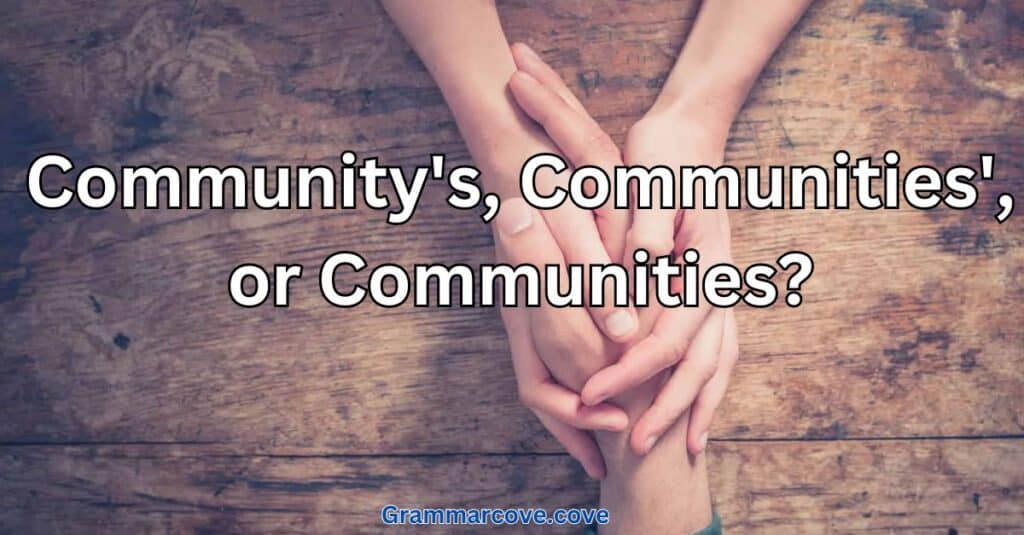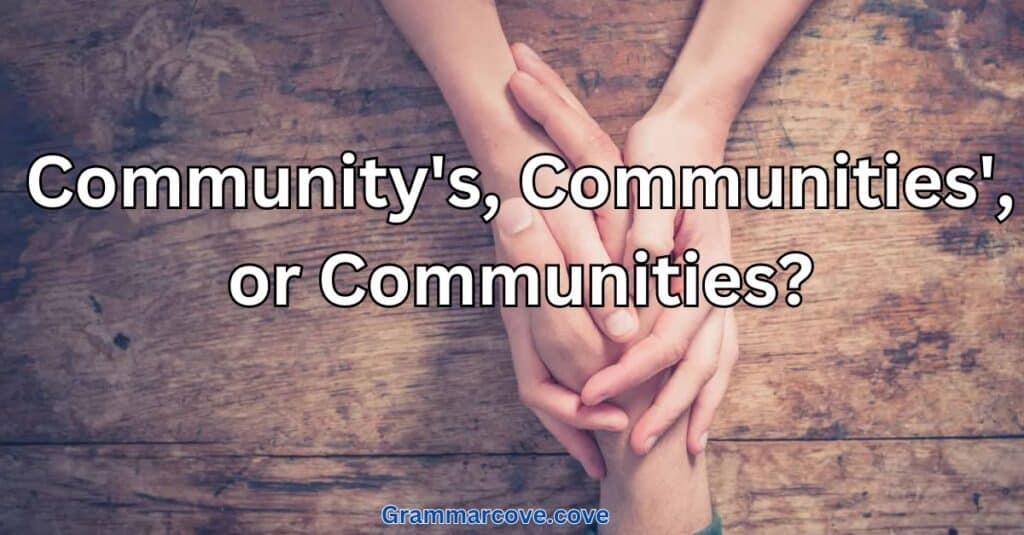When writing in English, understanding the difference between community’s, communities’, and communities can be a bit tricky, especially when dealing with singular possessive, plural possessive, and plural form. In this article, we’ll break down each one and explain when to use them correctly. Whether you’re drafting an email, writing a report, or communicating with others, mastering these distinctions will help you avoid common mistakes.

The Basics: Community’s, Communities’, or Communities?
At the core of understanding community’s, communities’, and communities lies in the distinction between singular, plural, and possessive forms. Let’s go through these step by step.
Community’s (Singular Possessive)
Community’s is the singular possessive form of the word. This means that you’re talking about something that belongs to a single community.
For example, let’s imagine you’re organizing a meeting in a small neighborhood. You want to write a formal email to inform the residents:
Subject: Important Meeting Regarding the Community’s Development
Dear Neighbors,
I hope this email finds you well. I am writing to inform you about the community’s upcoming development projects. As our community’s growth continues, it is crucial that we gather input from all residents. Please attend the meeting scheduled for Friday at 7:00 PM.
Sincerely,
Mark Stevens
Neighborhood Organizer
In this case, the community’s development refers to something specific to that single community. By using the singular possessive, you’re clearly stating that the development belongs to the community as a singular entity.
More Examples:
- The community’s park was renovated last year.
- We need to discuss the community’s annual event.
Communities (Plural Form)
Communities is the plural form of the word community. This means you are talking about more than one community, but you’re not indicating ownership or possession.
For instance, imagine you’re writing a report on urban planning and need to address multiple neighborhoods:
Subject: Improving Public Spaces Across Multiple Communities
Dear Council Members,
In this report, we will examine the public spaces in various communities throughout the city. Our goal is to ensure that each of these communities has access to well-maintained parks and recreational areas. By focusing on several different communities, we can create a cohesive urban strategy.
Best regards,
Sarah Lee
City Planner
In this example, communities simply refers to multiple communities—there’s no ownership implied. It’s just a plural noun indicating more than one neighborhood or group of people.
More Examples:
- Several communities came together for the festival.
- Rural and urban communities face different challenges.
Communities’ (Plural Possessive)
Communities’ is the plural possessive form. This means you are talking about something that belongs to more than one community.
Let’s imagine you’re writing an email to your boss about a new program that involves several neighborhoods:
Subject: Expanding the Program to Multiple Communities’ Schools
Hi Jason,
I wanted to update you on the new education initiative. We have decided to implement the program in several communities’ schools across the state. These schools will benefit greatly from the resources we are providing. It’s important that we engage with each of the communities’ leaders to ensure a smooth transition.
Regards,
Jessica Martin
Program Director
In this email, communities’ shows that the schools in multiple communities are involved. By using the plural possessive, you’re indicating that the schools belong to multiple communities.
More Examples:
- The communities’ combined efforts led to a successful charity event.
- Each of the communities’ projects was funded by the local government.
Common Mistakes and How to Avoid Them

It’s easy to mix up community’s, communities’, and communities, but paying attention to whether you’re dealing with a singular possessive, plural possessive, or just the plural form will help clarify things.
Mistake 1: Using Communities When You Mean Community’s
Sometimes, writers use communities when they mean to show ownership. For example:
Incorrect: The communities park was closed for repairs.
Correct: The community’s park was closed for repairs.
The first sentence is incorrect because communities is plural, not possessive. You need the singular possessive community’s to show that the park belongs to one community.
Mistake 2: Using Community’s for Multiple Communities
Another common mistake is using community’s when you’re talking about more than one community.
Incorrect: The community’s programs were funded by the state.
Correct: The communities’ programs were funded by the state.
In this case, multiple communities are involved, so the plural possessive communities’ is correct.
How to Remember the Differences
Here are some tips to keep the distinctions clear:
- If you’re talking about something that belongs to one community, use community’s.
- If you’re just referring to more than one community (but not showing ownership), use communities.
- If you’re talking about something that belongs to multiple communities, use communities’.
Practice Makes Perfect
To master these forms, try creating your own sentences and practicing them. Here’s a quick exercise to test your understanding:
- The new library is located in several __________ areas. (communities, community’s, or communities’?)
- We need to plan for the __________ annual festival. (community’s, communities’, or communities?)
- Each of the __________ leaders was invited to the meeting. (community’s, communities’, or communities?)
Answer key:
- communities
- community’s
- communities’

Conclusion: Get It Right Every Time
Whether you’re working on a formal email or just trying to perfect your English, knowing when to use community’s, communities’, or communities is crucial. Understanding the difference betweenthese three forms—community’s, communities’, and communities—can significantly improve the clarity of your writing.
To recap:
- Community’s (singular possessive) is used when talking about something that belongs to one community.
- Communities (plural form) refers to more than one community without indicating ownership.
- Communities’ (plural possessive) shows ownership for more than one community.
By paying attention to these details, you can avoid common mistakes and ensure your writing sounds polished and professional. Whether you’re drafting an email, writing a formal report, or simply engaging with others in written form, these rules will help you get it right every time.
More Practice for Perfection
Let’s add a few more practice sentences to make sure you’re confident with these forms:
- The community’s values were shared at the meeting. (singular possessive)
- All of the communities we visited had unique traditions. (plural form)
- We celebrated the communities’ successes in a joint event. (plural possessive)
Understanding when to use singular possessive, plural possessive, and plural form is a fundamental part of writing clearly and effectively in English. By incorporating this knowledge into your writing, you’ll not only improve your grammar but also communicate more confidently with your audience.
A Final Thought
Mastering the possessive forms of community might seem small, but it can make a big difference in professional communication. Whether you’re working on an email to your community’s leaders or discussing multiple communities’ challenges, precision matters. Being clear and accurate helps you stand out as a strong writer and communicator.
So next time you’re unsure whether to use community’s, communities’, or communities, take a moment to reflect on the meaning and context. By following these simple guidelines, you’ll be on your way to crafting sentences that are precise, professional, and easy to understand.

Steel Morgan is an experienced blogger passionate about language and writing. On Grammarcove. he shares his expertise in grammar, punctuation, and effective communication, making complex rules simple and accessible for readers. With a knack for clear explanations and engaging content, Steel aims to help others master the art of language.







